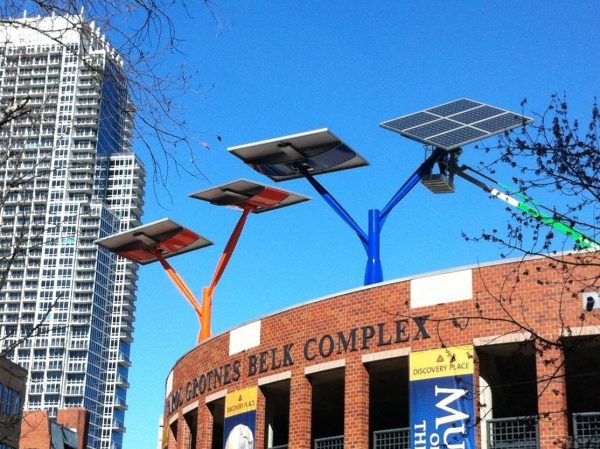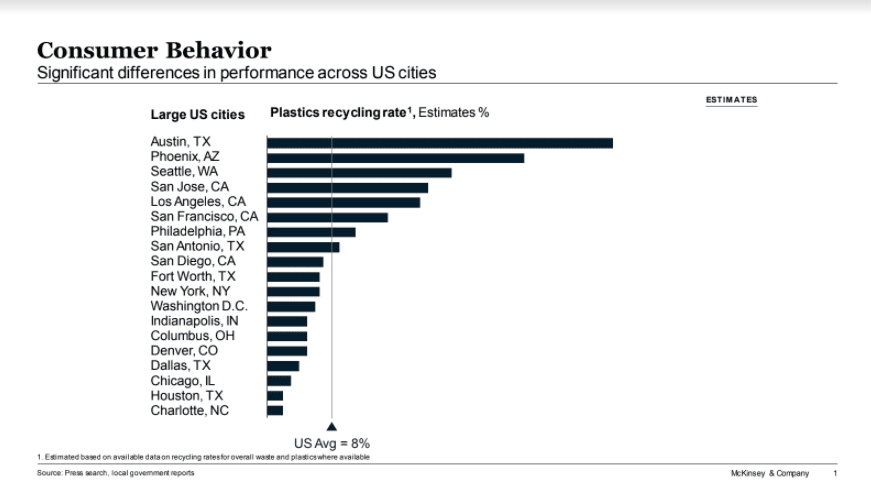Mobilizing for climate change: Evaluating the Strategic Energy Action Plan, two years in

Contributing writer Martin Zimmerman interviews Sarah Hazel, recently appointed as Chief Sustainability & Resiliency Officer for the city of Charlotte.
 Sarah Hazel comes to the Strategic Energy Action Plan team from a six-year tenure on the city manager’s staff, where she worked on a wide range of initiatives including SEAP program development. She now manages two full-time employees and a pair of consultants on loan to Charlotte via a $2.5 million Bloomberg American Cities Climate Challenge Progress grant.
Sarah Hazel comes to the Strategic Energy Action Plan team from a six-year tenure on the city manager’s staff, where she worked on a wide range of initiatives including SEAP program development. She now manages two full-time employees and a pair of consultants on loan to Charlotte via a $2.5 million Bloomberg American Cities Climate Challenge Progress grant.
City Council approved the SEAP in 2018. The SEAP Year 2 status report offers the public a snapshot of how her team is guiding the shift from fossil fuel dependence to a low carbon future in response to the ongoing climate change crisis. SEAP has two overarching goals: the first is to convert all municipal buildings and fleets to 100% energy derived from zero carbon sources by 2030; the second is to radically reduce overall city-wide emissions to less than 2 metric tons of CO₂e annually per person by 2050.
SEAP aligns with several other cities and towns in North Carolina which have embarked on their own climate action plans, and it is also consistent with Gov. Roy Cooper’s Executive Order 80 to transition to a clean energy economy and President Biden’s mandate to integrate climate change policy at all levels of the federal government.
……………………………………………………………………………………..
MZ: Hello Sarah. Let’s start with one of the short-term goals of the 2018 Strategic Energy Action Plan: “to ensure the success of SEAP, a key role of the City will be to make sure critical …decision-making processes are in place that support …internal implementation.” The Plan also stakes out a two-year window to establish an effective structure for inter-departmental collaboration. Can you describe this structure? And has the two-year goal been achieved?
SH: Yes, I’d say we have a strong foundational structure of citywide leadership; and yes, we have reached that initial goal. Although participating personnel do not all have “sustainability” in their work titles, teammates from across city agencies are collectively playing critical roles in policy development or implementation.
Specifically, we have set up what we call a “Strategic Energy Action Plan Operations Team” with representatives from each department. They meet regularly to provide feedback on policies and projects that impact our climate goals. Each member is called on to be a champion for SEAP and apply one’s particular expertise to support SEAP-related efforts. The operations team has been especially useful in crafting our Sustainable Fleet Policies and the revised Sustainable Facilities Policy.
MZ: What about external relationships? Thus far, most of the focus has been on building a partnership with Duke Energy. But what about other big players in the corporate and institutional sectors – CMS, local universities, major banks, Fortune 500 companies? Is it too early to lay the groundwork with these other entities?
SH: It’s never too early to lay the groundwork for external collaborations! In addition to our ongoing partnership with Duke Energy, we have a strong connection with UNC Charlotte, where we are partnering on a pilot electric vehicle charging project. We also recently signed an MOU to work with an innovative UK electric vehicle company, Arrival Ltd. They recently announced Charlotte as the location for their North American headquarters.
And we have a variety of corporate partners with the RENEW workforce development program. Trane technologies is the big one. Others include CBRE, MSS Solutions, and a number of local HVAC companies.
MZ: The Bloomberg Progress grant may expire in the coming months. What do you think will happen, or needs to happen, when Bloomberg exits Charlotte?
SH: The relationship with Bloomberg Philanthropies has helped us to increase capacity and lay a foundation during a time when many cities have had to slow down their work pace because of the pandemic. We expect the impact of our grant to extend far beyond the grant timeframe.
I am hopeful that there may be an extension of this grant or the possibility of other grants, but we are also preparing for ways to maximize our team effort within our existing budget parameters. We will continue to actively seek additional outside sources including the potential for federal assistance under the new administration. I look forward to new opportunities that may materialize in the years ahead.
MZ: Year 2030 will mark a critical benchmark. That’s the SEAP target date for city government to source 100% of the energy serving its buildings and motor vehicles from zero-carbon sources. It’s a daunting goal, considering that the City owns or rents 3.2 million square feet in 247 buildings and controls a fleet exceeding 3,500 cars and trucks.
Has a strategy been devised to reach zero carbon in only 8 years? Is a comprehensive inventory underway to provide the baseline for mapping out this strategy?
SH: With the right policies in place, a sustained focus on implementation and partnerships, an eye on emerging technology, and updates on an annual basis, I am confident we will be able to adjust ongoing strategies towards our zero-carbon goal for buildings and vehicles.
The Sustainable Facilities Policy update which City Council approved earlier this year includes an energy benchmarking requirement for all City buildings. As these benchmarking measures evolve, we will be in a stronger position to gauge the energy efficiency in all of our buildings, assign energy conservation solutions to the poorest performing buildings, and integrate the solutions into the budgeting process.
The update also requires solar elements on all new construction and roof replacement projects.The idea here is to responsibly maximize the growth of on-site clean energy for city-owned buildings.
There are two other items that could impact our 2030 goals for city buildings.
- Green Source Advantage Program (GSA) and Other Renewable Energy Credit Purchases – Such opportunities are important to pursue when they arise. We don’t know when and how often they come along, but we are poised to evaluate them when they do.
- A Cleaner Duke Grid Mix – An important element impacting Charlotte’s achievement of 2030 goals is the carbon intensity of Duke Energy’s grid mix. Governor Cooper’s Executive Order 80, Duke Energy’s own carbon reduction goals, along with engagement from utility customers, suggests Duke Energy’s grid mix needs to become less carbon intense between now and 2030. It’s important that we account for that in our strategy, because the fewer green house gases in Duke’s grid mix, the smaller the gap Charlotte has to close to achieve net zero carbon buildings. We chose to influence that mix in our response to Duke Energy’s latest Integrated Resource Plan,currently under review by the North Carolina Utilities Commission, where we encouraged Duke to retire their North Carolina coal plants as soon as possible.
On the fleet side, our sustainable fleet policy ensures that we replace our vehicles with lowest emission alternatives possible based on operational needs, available technology, and financial feasibility according to our total cost of ownership model. The City is also negotiating with eTrans Energy to enable a full transition to e-buses for the CATS fleet.
MZ: Erin Stanforth, an import from Oregon, was recently hired as Mecklenburg County’s newly-created Sustainability & Resiliency Manager. How do you see the city-county relationship developing now that Erin is potentially your counterpart ?
SH: I am so excited to work with Erin. (I believe she is actually from NC originally.) We have begun to meet regularly to share information and discuss how to partner for maximum impact. We see opportunities at the programmatic level, but also at the policy level. We want to maximize the collective voices of our agencies for community benefit.
MZ: Charlotte’s 2% rate for plastics recycling ranks last of 19 large U.S. cities. Other than at Trader Joe’s or ALDI, single-use plastic bags dominate the Charlotte grocery scene on an everyday basis. And grocery bags are only a tiny piece of the local waste jigsaw puzzle.
Although the 2018 Strategic Energy Action Plan notes that 4% of Charlotte’s greenhouse gas emissions are attributed to waste, this issue of concern is omitted from the SEAP year 2 summary. What consideration is being given to add waste reduction measures to SEAP’s 2030 and 2050 goals? And how does waste reduction mesh with a much larger Circular Economy vision for Charlotte?

Consumer behavior chart estimates by McKinsey Company for Envision Charlotte
SH: We know that substantial emissions come not only from how we dispose of products that we use daily, but they are also an important factor in how products are produced. That leads to the idea of a Circular Economy – a total economy that functions like nature – cycling materials and energy endlessly at a high value.
As you noted, waste is not yet a foundational component of SEAP implementation. But I can foresee more opportunities to incorporate circular principles into SEAP-related actions in the future. So far, strategies towards a zero waste Circular Economy are being led by the local non-profit partner, Envision Charlotte.
The city’s Green Crown Program focuses on waste reduction in our local food and beverage establishments, where many establishments use waste reduction strategies including recyclable packaging; email receipts instead of paper; eliminating the use of Styrofoam; and recycling food waste and/or compost.
MZ: Charlotte will soon tap into zero carbon energy from a huge solar farm complex in Iredell county via the Duke Energy Green Source Advantage Program (GSA). What is the significance of this program? Are there additional solar or wind farm opportunities in the offing ?
SH: This is very significant. This utility-scale solar energy project made Charlotte the nation’s most populous city to acquire new renewable energy through what’s called a “utility green tariff”. Once operational, the solar farm will help offset about 25% of carbon emissions from city-owned buildings over the twenty year contract term. It is also projected to save the City nearly $2 million in energy expenses, not to mention improved air quality overall in the region. We expect it to create about 428 jobs, produce enough electricity to power 10,000 homes annually, and reduce carbon emissions equivalent to 12,000 fewer passenger vehicles on the road.
Renewable energy credits are also coming from Anheuser-Busch, who released a low carbon aluminum can pilot in our region in early 2021 in an effort to test innovative technology. As a result of this partnership the City was donated the equivalent of enough wind energy credits to power all city-owned facilities for a week.
Solar and wind opportunities also pertain to Duke Energy’s proposed Integrated Resource Plan mentioned above in the context of our 2030 goals. Our recent comments to the Utilities Commission encouraged Duke Energy to utilize more renewable energy in their resource planning and to increase the utility-scale renewable energy procurement opportunities available to large customers, including local governments like Charlotte. Our preference is to always look for opportunities that are locally accessible and have maximum air quality and workforce development benefits.
In addition, we are prioritizing city-owned rooftops for PV solar systems to reach our SEAP goals. In the FY21 budget, City Council approved $2 million for rooftop solar. We are planning to start construction on the first three rooftop solar systems in the next two months.
MZ: In anticipation of a growing need for green jobs, in 2020 Charlotte embarked on an effort called RENEW (Renewable Energy and Efficiency Workforce Training Program). RENEW currently provides paid training in the area of HVAC and electrical trades for 40 Charlotteans displaced from employment by COVID-19. In 2021, the city secured additional funds to train 80 participants through a partnership with the Urban League of the Central Carolinas and Goodwill Industries. But won’t this job creation supply stream need to be dramatically ramped up in order to reach net-zero carbon emission levels by 2030?
SH: We are not starting from scratch in terms of our buildings and clean energy workforce. At the rate at which we are building new buildings and doing renovations, we have not yet seen a skilled labor shortage that will impact our actions. I think the real challenge is to build out momentum and look for scaling opportunities with our partners that will ensure that the entire community has a local skilled workforce that will take us past our 2030 goals and towards our 2050 goals as technology rapidly advances and the market grows.
The RENEW program is a great example of building out the capacity in line with where the market is (so people can get employed NOW), where the market will continue to grow, and at the same time prioritizing equity in workforce development. This is critical as we want our workforce programs to result in hiring opportunities for all residents. Thus far, 39 Charlotte residents have graduated and 19 have been placed into full time jobs. We also have an active cohort now who will graduate next month, and a fourth cohort that will begin in May.
MZ: Notwithstanding that we’re only 2 years into the SEAP 2030 timeline, do you think the overall rate of carbon emission reduction is proceeding on target? Or must we wait for another emissions inventory to answer that question?
SH: I believe that our actions are on the right track, based on the 2018 inventory. But it will take a couple more years of inventory updates and implementation to more accurately determine if the impact of those policies and investments translates into carbon emissions reductions that are consistent with our timeline.
MZ: Picture a sunny summer day. The year is 2050, and you are harvesting some rhubarb with your grandchildren in a neighborhood community garden. The air is fresh and weather cycles are moderate, largely because Charlotte has become a low carbon city where residents have met the 2018 SEAP goal by reducing their per-person carbon emissions from 12 tons of CO₂e to less than 2 tons annually. Can you add some more images to this picture book of what a 2050 world could look like?
SH: What a nice question and image! I view Charlotte 2050 as a sustainable city where neighborhoods are equitably serviced by transit, bikeways, wide sidewalks and health-enhancing greenway trails . Despite my advancing age, I can easily navigate to my favorite pastimes with my grandkids, walking to the park or riding transit to museums and restaurants. The ingredients in my meals are locally grown. Asthma rates are down, and neither race or income level is any longer a determinant of environmental health impacts. When I go to sleep at night, I smile because I know that Charlotte has succeeded in creating a low-carbon legacy that will impact future generations.